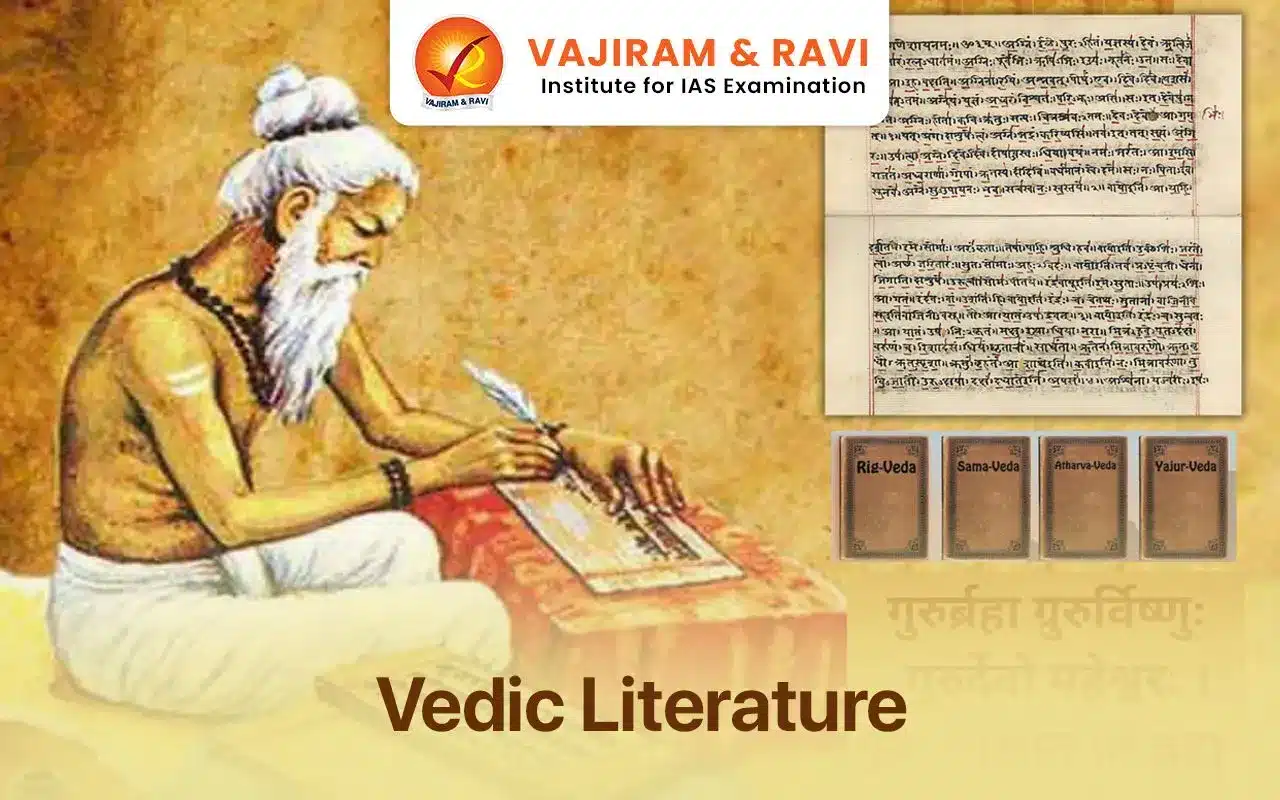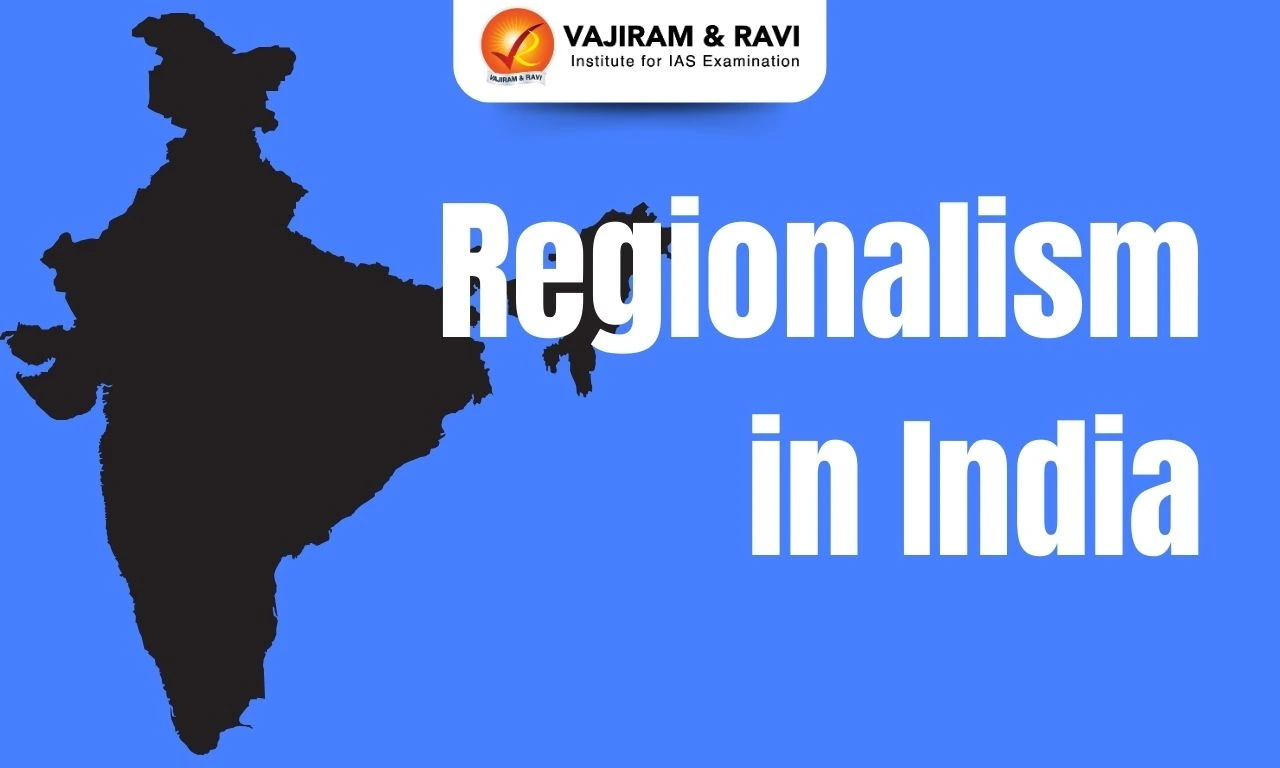The Vedas are the earliest Hindu scriptures written in Vedic Sanskrit, dating back to around 1500-1000 BCE and were composed among the Indo-Aryan people of the northwestern Indian subcontinent. The term “Vedic literature” refers to texts that are based on or derived from the Vedas. The Vedic literature is composed of four main texts: The four Vedas (Samhitas), the Brahmanas attached to each of the Samhitas, the Aranyakas, the Upanishads, and the Vedangas.
The Vedas offer an insight into early Indian society, culture, religion, and language. They form the principal foundation for Hinduism and have significantly contributed to Indian art, literature, and philosophy.
Vedic Literature Definition
The word “Veda” in Sanskrit means “knowledge” or “wisdom”. According to Hinduism, the Vedas contain answers to fundamental existential questions regarding the Divine, the universe, and the purpose of human existence. They are a collection of scriptural sounds that encode fundamental cosmic truths and have been in existence since the beginning of time. The Vedas are defined by the following core principles:
- They were revealed to ancient seers during deep meditation rather than being authored by historical figures at specific moments.
- They are Sruti, meaning “that which is heard”, and are distinct from later composed Smriti, which documents traditions and is “that which is remembered”.
- They are the central authority for deriving doctrines in orthodox Astika schools, receiving reverential titles such as Chaturveda “four Vedas” or trayī vidyā “triple knowledge”.
- Thus, the Vedas form the foundation of Hinduism as Śruti pramāṇa, or “evidence from scripture”, supporting the vast diversity of Hindu thoughts and rituals.
Vedas
The Vedas consist of the Rig-Veda, Samaveda, Yajurveda, and Atharvaveda. The first three Vedas, collectively known as Vedatrayi, are considered the oldest and most important. The Atharvaveda is a later addition.
- Bharatamuni’s Natyasastra is also considered a type of Veda known as the panchama Veda (fifth Veda).
- The Vedas are a voluminous literary work and have never been in written form in their formative phases.
Parts of the Vedas
Scholars differ on the issue of “parts” or “sections” of the Vedas. While some scholars believe that the Vedas are composed of two parts, the Samhitas and the Brahmanas, others believe that each of the Vedas is divided into four parts or sections: the Samhitas, the Brahmanas, the Aranyakas, and the Upanishads.
- The Samhitas and the Brahmanas form the Karma-Kanda segment of the Vedas, while
- The Aranyakas and the Upanishads form the Gyan-Kanda segment.
Samhitas
The Samhitas are the first part of each of the Vedas and are a collection of mantras. Most of the mantras or hymns were concerned with nature and deities. The ancient man worshipped the elements of nature as deities, and these deities are believed to be symbolic.
- The mantras are generally addressed to the gods and goddesses. Some Western scholars believe that the Vedic man used the mantras in sacrificial ceremonies and mystic rituals, which may be true for some mantras.
- Swami Dayananda Saraswati and Shri Aurobindo worked on understanding the Vedas and its mantras. The Samhitas are named after the Vedas they belong to.
- The Rig-Samhita contains hymns known as “richas.”
- The Sam-Samhita has mantras in song form for public worship.
- The Yajur-Samhita has various mantras in poetical and prose forms, and
- The Atharva-Samhita has mantras for routine rites and rituals.
- Rig Veda: The Rig Veda is the oldest of all the Vedas. It contains 1028 hymns (sukta) that are divided into ten mandalas.
- The hymns are addressed to various gods and are recited during sacrificial rites and other rituals.
- Mandalas 2 to 7 are considered the earliest of all compositions.
- The tenth mandala was added later, and it contains the famous Purushasukta, which explains the origins of the four varnas (castes).
- Samaveda: The Samaveda is a collection of melodies that were meant to be sung during the Soma sacrifice.
- It consists of 1603 verses that have been borrowed from the Rig Veda.
- The Jha Samaveda is important in tracing the history of Indian music.
- Yajurveda: The Yajurveda prescribes the procedures to be adopted during different sacrifices.
- There are two main texts of the Yajurveda: Sukla Yajurveda or Vajasaneyi (Madhyandin and Kanva) and Krsna-Yajurveda (Taittiriya, Kathaka, Maitrayani, and Kapisthal).
- It is a collection of short magic spells used by a certain class of priests at the time of sacrifices.
- Atharvaveda: The Atharvaveda is different from the other three Vedas in terms of content and style. It is the latest of the four, but it is equally important and interesting.
- It describes the popular beliefs and superstitions of the humble folk. For a long time, it was not included in the category of the Veda.
- It is divided into 20 kandas and has 711 hymns and a collectionof 5987 mantras. Most of these hymns are used to ward off evil spirits.
- The Atharvaveda has two different divisions: Paippalada and Saunakiya. Each Veda has its own Samhita and Commentary.
Brahmanas
The Brahmanas are the second part of the Vedas. They were created to explain the mantras of the Samhitas, which were becoming difficult to understand. The word “Brahmana” comes from “brahman”, meaning “prayer” or “devotion”. They contain explanations of the sacrificial rituals and hint at the secret power behind them. Each Veda has several Brahmanas.
- The two Brahmanas attached to the Rig Veda are Aitareya Brahmana and Kausitaki Brahmana, which were composed by Hotri-priests or invokers (the priests who recite mantras of the Rig Veda at sacrifices).
- The Sukla Yajurveda is appended with Satapatha Brahmana, which recommends ‘one hundred sacred paths’ (Satapatha).
- It is the most exhaustive and important of all the Brahmanas.
- The Gopatha Brahmana is appended to the Atharvaveda. These Brahmanas are elaborate commentaries on the various hymns in Samhitas.
Aranyakas
The Aranyakas(forest books) form the third part of the Vedas and were developed by hermits who lived in the forests. These are the concluding portions of the Brahmanas or their appendices. A strict code of secrecy was maintained over the Aranyakas as it was believed that the contents would spell danger if taught to the uninitiated. Hence, they were to be studied in the forest.
- They deal with mysticism and symbolism.
- They form the natural transition of the Upanishads.
- They offer the bridge between Karma marga (way of deeds) which was the sole concern of the Brahmanas and the jnana marga (way of knowledge) which the Upanishads advocated.
Upanishads
The Upanishads are philosophical and spiritual texts that mark the culmination of ancient Indian philosophical ideas. The word ‘Upanishad’ is derived from the root ‘upani-sad,‘ meaning ‘to sit down near someone,’ signifying a student sitting at the feet of their guru to learn secret knowledge.
- Origins and classification: Composed between 800 BC and 500 BC, there are 108 Upanishads classified according to the Vedas.
- Ten outstanding ones: Isha, Kena, Katha, Prashna, Mundaka, Mandukya, Chhandogya, Brahadaranyaka, Aitereya, and Taitteriya.
- Scholars: Shvetashvatara, Maitri, and Kautishaki.
- Upanishads are associated with different Vedas like Aitereya (Rig), Kena (Sama), Isha (Shukla Yajur), Katha (Krishna Yajur), and Prashna (Atharva).
- Contributors: Notable contributors to the Upanishads include Maharshi Yagnavalkya, Rajarshi Janak, Mandukya Muni, and Pippalad Muni.
- Maharshi Yagnavalkya significantly contributed to the Brahadaranyaka Upanishad.
- Language and content: Written in classical Sanskrit, the Upanishads give less importance to ceremonies and sacrifices.
- They discuss theories on the creation of the Universe, define the doctrine of Karma (action), and treat Brahman (God) and Atman (soul) as identical.
- They profess the goal of life as attaining moksha (salvation) through meditation and self-control.
- Significance: The Upanishads are the foundation of later Indian philosophy, influencing thinkers like Sankara, Ramanuja, Ramakrishna Paramahansa, and Aurobindo.
- India’s national motto, “Satyameva Jayate,” is taken from the Mundakopanishad, highlighting its enduring relevance.
Vedangas
The Vedangas likely developed towards the end of the Vedic period, around or after the middle of the 1st millennium BCE. They emerged because the language of the Vedic texts composed centuries earlier grew too archaic for the people of that time.
- Vedangas are the six auxiliary disciplines associated with the study and understanding of the Vedas in Hinduism.
- They serve as “limbs” that support and enhance the study, preservation, and interpretation of the Vedas.
- The six Vedangas are Shiksha (phonetics), Kalpa (ritual), Vyakarana (grammar), Nirukta (etymology), Chandas (meter), and Jyotisha (astronomy).
- Shiksha and Chandas aid in the proper recitation of Vedic mantras, while Vyakarana and Nirukta help understand their meaning.
- Jyotisha and Kalpa guide on the appropriate times and methods for performing Vedic rituals.
- The Vedangas played a crucial role in maintaining the purity and integrity of the Vedic tradition over centuries.
Vedic Literature UPSC PYQs
Question 1: The national motto of India, ‘Satyameva Jayate’ inscribed below the Emblem of India is taken from (UPSC Prelims 2014)
- Katha Upanishad
- Chandogya Upanishad
- Aitareya Upanishad
- Mundaka Upanishad
Answer: (d)
Last updated on April, 2025
→ UPSC Notification 2025 was released on 22nd January 2025.
→ The UPSC Vacancy 2025 were released 1129, out of which 979 were for UPSC CSE and remaining 150 are for UPSC IFoS.
→ UPSC Admit Card 2025 is expected to release in first week of May for CSE Prelims Exam 2025.
→ The UPSC Prelims 2025 is scheduled to be conducted on 25th May 2025 and UPSC Mains 2025 will be conducted on 22nd August 2025.
→ Apply once through it and aspirants can apply for various government exams conducted by UPSC.
→ The UPSC Selection Process is of 3 stages-Prelims, Mains and Interview.
→ UPSC Result 2024 is released with latest UPSC Marksheet 2024. Check Now!
→ UPSC Toppers List 2024 is released now. Shakti Dubey is UPSC AIR 1 2024 Topper.
→ Also check Best IAS Coaching in Delhi
Vedic Literature FAQs
Q1. What is Vedic literature?+
Q2. Over what period was Vedic literature composed?+
Q3. What major texts are included in Vedic literature?+
Q4. What topics are covered in Vedic literature?+
Q5. How has Vedic literature influenced Indian traditions?+
Tags: quest vedic literature
















